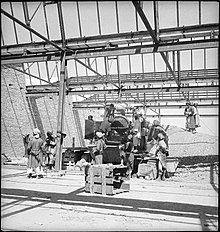Puli Khumri
Puli Khumri
پلخمری | |
|---|---|
 View of the city | |
| Coordinates: 35°57′N 68°42′E / 35.950°N 68.700°E | |
| Country | |
| Province | Baghlan Province |
| District | Puli Khumri District |
| Elevation | 635 m (2,083 ft) |
| Population (2007) | |
| • City | 58,300 |
| • Urban | 221,274[1] |
| Time zone | UTC+4:30 (Afghanistan Standard Time) |
| Website | Rd |
Puli Khumri (پلخمری), also spelled Pul-i-Khumri or Pol-e Khomri, is a city in northern Afghanistan. Located about 100 kilometres (60 mi) south of Kunduz, 200 kilometres (120 mi) southeast of Mazar-i-Sharif, and 230 kilometres (140 mi) north of Kabul, Puli Khumri is the capital and largest city of Baghlan Province, whose name comes from the other major town in the province, Baghlan.[2] The city of Puli Khumri has a population of 221,274 (in 2015).[3] It has 6 districts and a total land area of 3,752 hectares.[4] The total number of dwellings in the city are 24,586.[5]
Climate
With an influence from the local steppe climate, Puli Khumri features a cold semi-arid climate (BSk) under the Köppen climate classification. The average temperature in Puli Khumri is 15.9 °C, while the annual precipitation averages 282 mm.
July is the hottest month of the year with an average temperature of 28.5 °C. The coldest month January has an average temperature of 3.0 °C.
| Climate data for Pul-e-Khumri | |||||||||||||
|---|---|---|---|---|---|---|---|---|---|---|---|---|---|
| Month | Jan | Feb | Mar | Apr | May | Jun | Jul | Aug | Sep | Oct | Nov | Dec | Year |
| Mean daily maximum °C (°F) | 8.3 (46.9) |
10.9 (51.6) |
16.2 (61.2) |
21.8 (71.2) |
28.7 (83.7) |
35.3 (95.5) |
37.1 (98.8) |
35.9 (96.6) |
31.6 (88.9) |
24.8 (76.6) |
15.7 (60.3) |
9.6 (49.3) |
23.0 (73.4) |
| Daily mean °C (°F) | 3.0 (37.4) |
5.7 (42.3) |
10.7 (51.3) |
16.0 (60.8) |
21.3 (70.3) |
26.5 (79.7) |
28.5 (83.3) |
27.0 (80.6) |
22.5 (72.5) |
16.5 (61.7) |
9.1 (48.4) |
4.2 (39.6) |
15.9 (60.7) |
| Mean daily minimum °C (°F) | −2.2 (28.0) |
0.6 (33.1) |
5.3 (41.5) |
10.2 (50.4) |
14.0 (57.2) |
17.8 (64.0) |
19.9 (67.8) |
18.1 (64.6) |
13.4 (56.1) |
8.2 (46.8) |
2.5 (36.5) |
−1.1 (30.0) |
8.9 (48.0) |
| Average precipitation mm (inches) | 31 (1.2) |
43 (1.7) |
63 (2.5) |
65 (2.6) |
27 (1.1) |
0 (0) |
0 (0) |
0 (0) |
0 (0) |
8 (0.3) |
20 (0.8) |
25 (1.0) |
282 (11.2) |
| Source: Climate-Data.org[6] | |||||||||||||
Land use

Puli Khumri is a trading and transit hub in the region, and the second-largest city in northeastern Afghanistan after Kunduz.[7] Agricultural lands account for the largest land use in Puli Khumri (65%), with the majority of that land in Districts 3, 5 and 6.[8] Districts 1 and 2 have the highest dwelling densities but District 5 is home to the most dwelling units.[9] Puli Khumri has a diverse housing stock consisting of regular, irregular and hillside houses as well as apartment buildings.[10]
War history
As of 2017, Taliban insurgents are active in the Dand-e-Shahabuddin part of Puli Khumri.[11] On May 5, 2019, Taliban members stormed the city's police headquarters, killing 13 police.[12] On September 1, 2019, Taliban assaulted the city,[13] but were repelled by the Afghan Army.
Economy
There are two dams in Puli Khumri, which provides the necessary electricity.
Afghanistan's first cement factory was built in 1954 in Puli Khumri with financial support from Czechoslovakia. It is currently owned and operated by Afghan Invest Co., and operated by Ahmad Javid Jaihoon[14]. The limestone is mined from the hill behind the factory.[15]
There is a coal mine outside of the city in the village Kar-kar, but the production system is archaic.
Agriculture is very important because of the rain and temperature; wheat and rice are the main crops.
Provincial Reconstruction Team
Hungary headed a Provincial Reconstruction Team in the city until March 2013.[16]
Electrical transmission lines built from Puli Khumri are now bringing a steady supply of electricity to Kabul.
See also
References
- ^ "The State of Afghan Cities report 2015". Archived from the original on 2015-10-31. Retrieved 2015-10-21.
- ^ Dupree, Nancy Hatch (1977) [1st Edition: 1970]. An Historical Guide to Afghanistan (2nd Edition, Revised and fEnlarged ed.). Afghan Tourist Organization.
{{cite book}}: Cite has empty unknown parameter:|month=(help) - ^ "The State of Afghan Cities report2015". Archived from the original on 2015-10-31. Retrieved 2015-10-21.
- ^ "The State of Afghan Cities report (2015". Archived from the original on 2015-10-31. Retrieved 2015-10-21.
- ^ "The State of Afghan Cities report2015". Archived from the original on 2015-10-31. Retrieved 2015-10-21.
- ^ "Climate: Pul-e-Khumri - Climate-Data.org". Retrieved 9 September 2016.
- ^ "The State of Afghan Cities report 2015". Archived from the original on 2015-10-31. Retrieved 2015-10-21.
- ^ "The State of Afghan Cities report 2015". Archived from the original on 2015-10-31. Retrieved 2015-10-21.
- ^ "The State of Afghan Cities report 2015". Archived from the original on 2015-10-31. Retrieved 2015-10-21.
- ^ "The State of Afghan Cities report 2015". Archived from the original on 2015-10-31. Retrieved 2015-10-21.
- ^ https://tolonews.com/afghanistan/pul-e-khumri-residents-speak-out-about-ongoing-battles
- ^ https://wtop.com/asia/2019/05/afghan-officials-taliban-launch-complex-attack-on-police/
- ^ https://www.aljazeera.com/news/2019/09/taliban-attacks-afghan-city-talks-wrap-190901051603411.html
- ^ http://www.afghancement.af
- ^ Magyar, Honvedseg (2010). "Baghlan taromány CIMIC kézikönyve" (PDF). Magyar Honvédség ÖHP. Archived from the original (PDF) on 2013-12-13.
- ^ McMahon, Robert (October 20, 2005). "Afghanistan: PRTs Spreading, Though Impact Remains Unclear". Radio Free Europe / Radio Liberty. Retrieved 2007-12-19.

